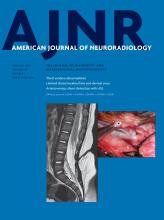Index by author
Thomas, A.
- NeurointerventionYou have accessEmbolization of Intracranial Dural Arteriovenous Fistulas Using PHIL Liquid Embolic Agent in 26 Patients: A Multicenter StudyS. Lamin, H.S. Chew, S. Chavda, A. Thomas, M. Piano, L. Quilici, G. Pero, M. Holtmannspolter, M.E. Cronqvist, A. Casasco, L. Guimaraens, L. Paul, A. Gil Garcia, A. Aleu and R. ChapotAmerican Journal of Neuroradiology January 2017, 38 (1) 127-131; DOI: https://doi.org/10.3174/ajnr.A5037
Thomas, B.
- Adult BrainYou have accessCollateral Assessment by CT Angiography as a Predictor of Outcome in Symptomatic Cervical Internal Carotid Artery OcclusionS. Sundaram, S. Kannoth, B. Thomas, P.S. Sarma and P.N. SylajaAmerican Journal of Neuroradiology January 2017, 38 (1) 52-57; DOI: https://doi.org/10.3174/ajnr.A4957
Tokutake, T.
- Adult BrainOpen AccessDiagnostic Value of Brain Calcifications in Adult-Onset Leukoencephalopathy with Axonal Spheroids and Pigmented GliaT. Konno, D.F. Broderick, N. Mezaki, A. Isami, D. Kaneda, Y. Tashiro, T. Tokutake, B.M. Keegan, B.K. Woodruff, T. Miura, H. Nozaki, M. Nishizawa, O. Onodera, Z.K. Wszolek and T. IkeuchiAmerican Journal of Neuroradiology January 2017, 38 (1) 77-83; DOI: https://doi.org/10.3174/ajnr.A4938
Tomsick, T.A.
- FELLOWS' JOURNAL CLUBNeurointerventionOpen AccessEndovascular Therapy of M2 Occlusion in IMS III: Role of M2 Segment Definition and Location on Clinical and Revascularization OutcomesT.A. Tomsick, J. Carrozzella, L. Foster, M.D. Hill, R. von Kummer, M. Goyal, A.M. Demchuk, P. Khatri, Y. Palesch, J.P. Broderick, S.D. Yeatts, D.S. Liebeskind and for the IMS III InvestigatorsAmerican Journal of Neuroradiology January 2017, 38 (1) 84-89; DOI: https://doi.org/10.3174/ajnr.A4979
The authors reviewed the impact of revascularization on clinical outcomes in 83 patients with M2 occlusions in the Interventional Management of Stroke III trial according to specific M1–M2 segment anatomic features. AnmRS 0–2 outcome was associated with reperfusion for M2 trunk (n = 9) or M2 division (n = 42) occlusions, but not for M2 branch occlusions (n = 28). Of the 83 participants with M2 occlusion who underwent endovascular therapy, 41.0% achieved mRS 0–2 at 90 days, including 46.6% with modified TICI 2–3 reperfusion compared with 26.1% with modified TICI 0–1 reperfusion. They conclude that mRS 0–2 at 90 days was dependent on reperfusion for M2 trunk but not for M2 branch occlusions in IMS III.
Tu, R.K.
- You have accessGenetics of Frontotemporal DementiaF.W. Rohlfing and R.K. TuAmerican Journal of Neuroradiology January 2017, 38 (1) 10-11; DOI: https://doi.org/10.3174/ajnr.A4972
Tulamo, R.
- NeurointerventionOpen AccessFlow Conditions in the Intracranial Aneurysm Lumen Are Associated with Inflammation and Degenerative Changes of the Aneurysm WallJ. Cebral, E. Ollikainen, B.J. Chung, F. Mut, V. Sippola, B.R. Jahromi, R. Tulamo, J. Hernesniemi, M. Niemelä, A. Robertson and J. FrösenAmerican Journal of Neuroradiology January 2017, 38 (1) 119-126; DOI: https://doi.org/10.3174/ajnr.A4951
Turjman, F.
- You have accessMore Transparency Is Needed in the Reporting of Clinical Research StudiesX. Armoiry, F. Turjman and B. GoryAmerican Journal of Neuroradiology January 2017, 38 (1) E6-E7; DOI: https://doi.org/10.3174/ajnr.A4982
Vajapeyam, S.
- Pediatric NeuroimagingYou have accessAutomated Processing of Dynamic Contrast-Enhanced MRI: Correlation of Advanced Pharmacokinetic Metrics with Tumor Grade in Pediatric Brain TumorsS. Vajapeyam, C. Stamoulis, K. Ricci, M. Kieran and T. Young PoussaintAmerican Journal of Neuroradiology January 2017, 38 (1) 170-175; DOI: https://doi.org/10.3174/ajnr.A4949
Valsasina, P.
- EDITOR'S CHOICEAdult BrainOpen AccessHippocampal and Deep Gray Matter Nuclei Atrophy Is Relevant for Explaining Cognitive Impairment in MS: A Multicenter StudyD. Damjanovic, P. Valsasina, M.A. Rocca, M.L. Stromillo, A. Gallo, C. Enzinger, H.E. Hulst, A. Rovira, N. Muhlert, N. De Stefano, A. Bisecco, F. Fazekas, M.J. Arévalo, T.A. Yousry and M. FilippiAmerican Journal of Neuroradiology January 2017, 38 (1) 18-24; DOI: https://doi.org/10.3174/ajnr.A4952
Brain dual-echo, 3D T1-weighted, and double inversion recovery scans were acquired at 3T from 62 patients with relapsing-remitting MS and 65 controls. Focal WM and cortical lesions were identified, and volumetric measures from WM, cortical GM, the hippocampus, and deep GM nuclei were obtained. Compared with those with who were cognitively preserved, patients with MS with cognitive impairment had higher T2 and T1 lesion volumes and a trend toward a higher number of cortical lesions. Significant brain, cortical GM, hippocampal, deep GM nuclei, and WM atrophy was found in patients with MS with cognitive impairment versus those who were cognitively preserved. The authors conclude that hippocampal and deep GM nuclei atrophy are key factors associated with cognitive impairment in MS.
Van Den Berg-huijsmans, A.A.
- Adult BrainOpen AccessInfluence of Small Vessel Disease and Microstructural Integrity on Neurocognitive Functioning in Older Individuals: The DANTE Study LeidenJ.E.F. Moonen, J.C. Foster-Dingley, A.A. van den Berg-Huijsmans, W. de Ruijter, A.J.M. de Craen, J. van der Grond and R.C. van der MastAmerican Journal of Neuroradiology January 2017, 38 (1) 25-30; DOI: https://doi.org/10.3174/ajnr.A4934








